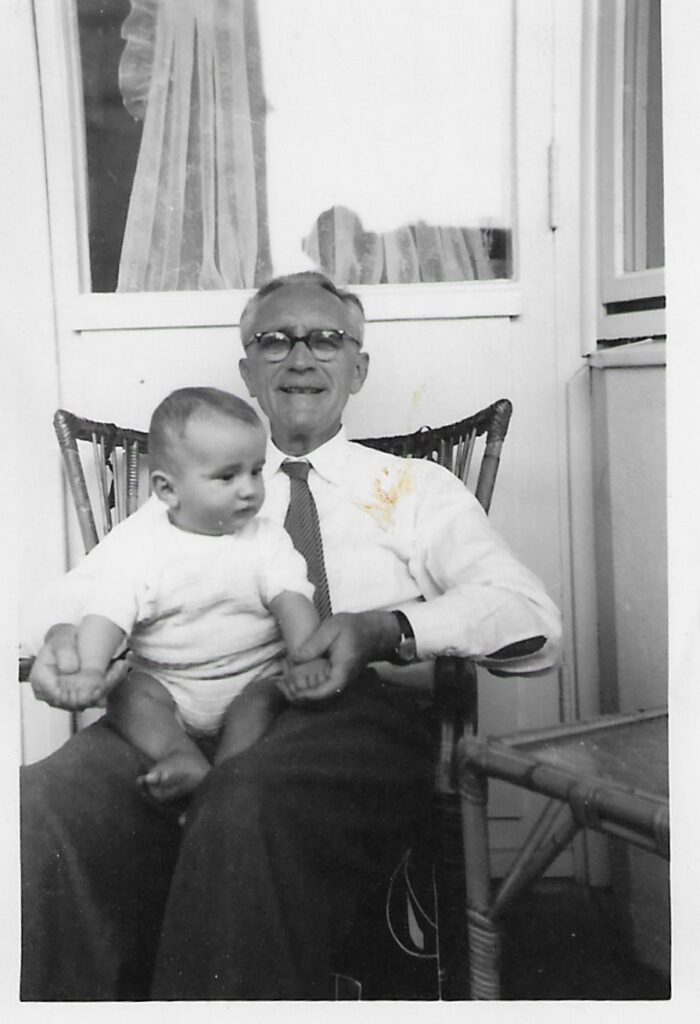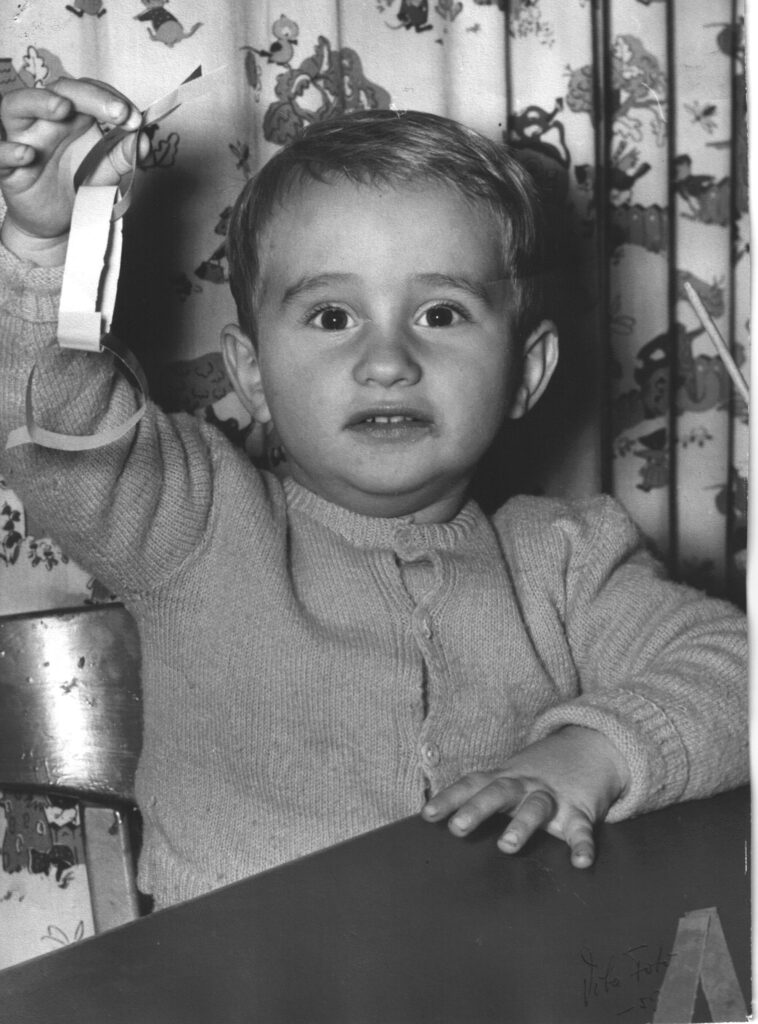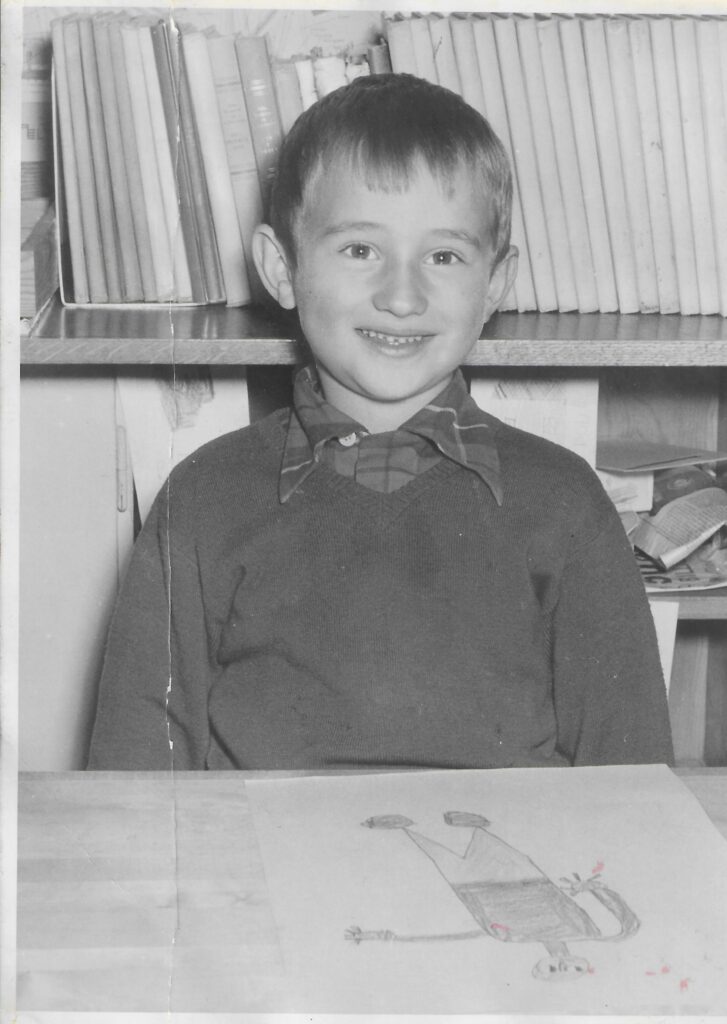Starten
Mor, far og bror Jakki bodde på hjørnet av Drammensveien og Gabelsgate på Skillebekk så det var nok ikke mer enn 150 meter opp til Røde kors der jeg skulle ta mitt første åndedrag. Etter reisen ned igjen til Dr.veien (61), ble jeg boende der i de neste 24 år.
Skillebekk var et fantastisk område å vokse opp i. Nære til barnehave fra kl 10-14 hos ”tante Ma” i Mogga-parken. Fontenen i Skillebekkparken ble brukt både til avkjøling og til race med lekebåter. Parken hadde snille fylliker (Sverre m fl.). Eneste trauma var to sesonger på Ellinor Svendsen’s danseskole.
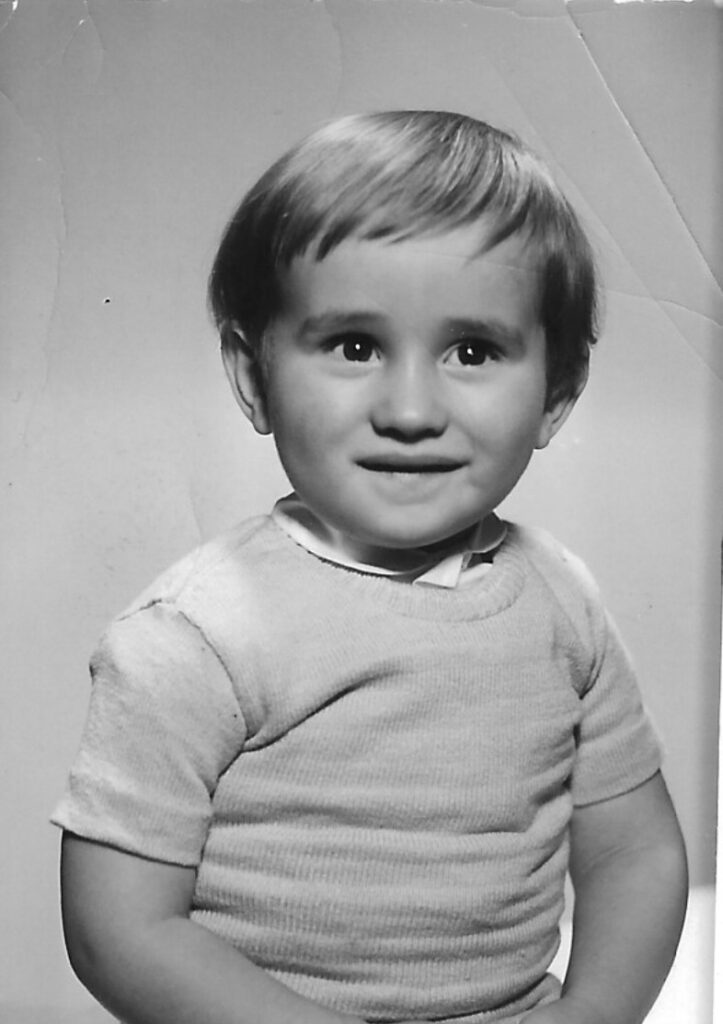
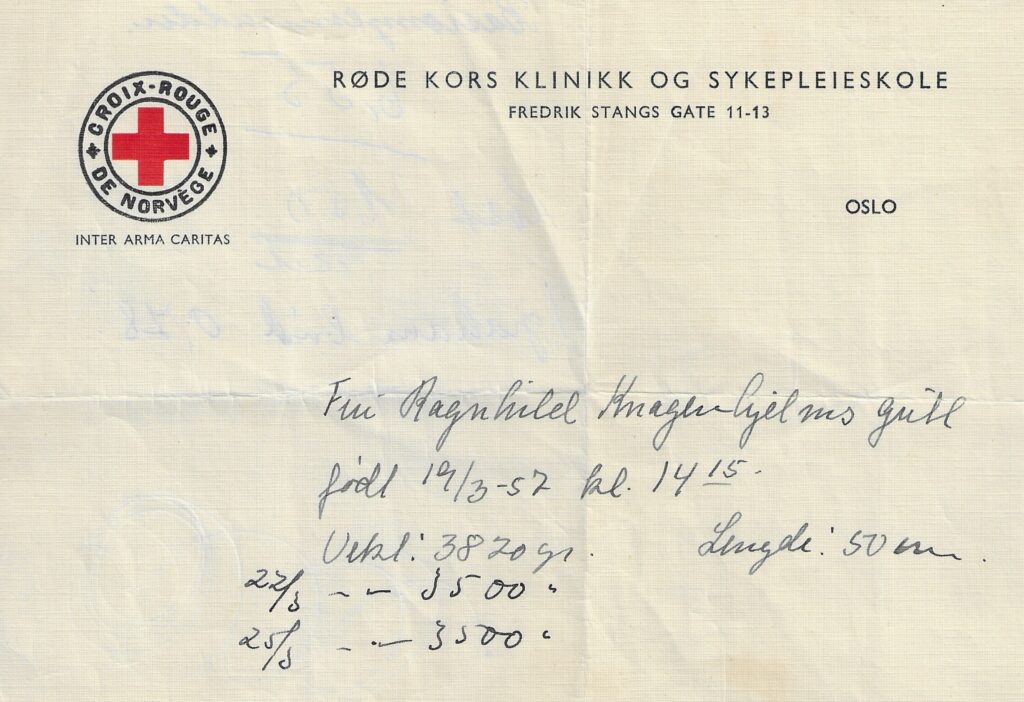
Født i Oslo på Røde Kors, kl. 14:15 19- mars 1957. Vekt 3870g og med en lengde på 50cm. Som kuriosa kan nevnes at på baksiden står det att et Graham brød er innkjøpt for kr. 0,78.
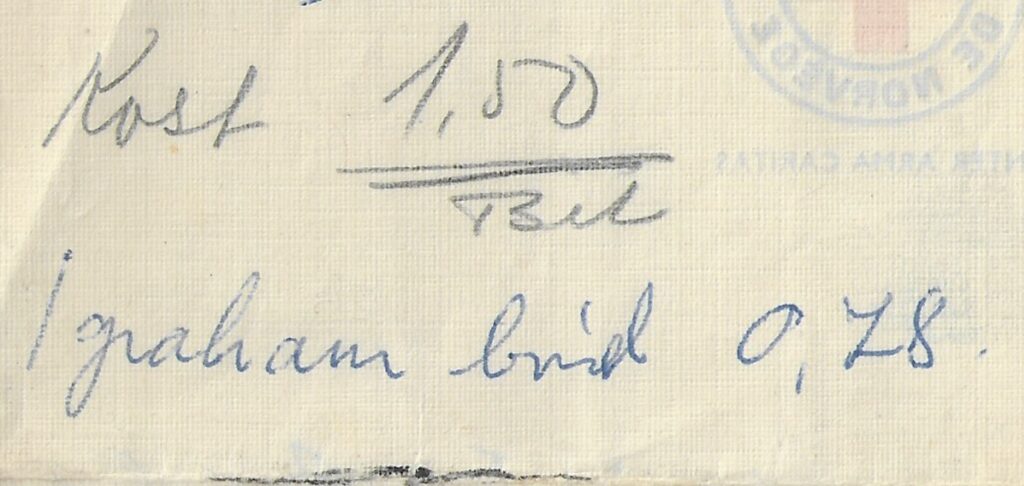
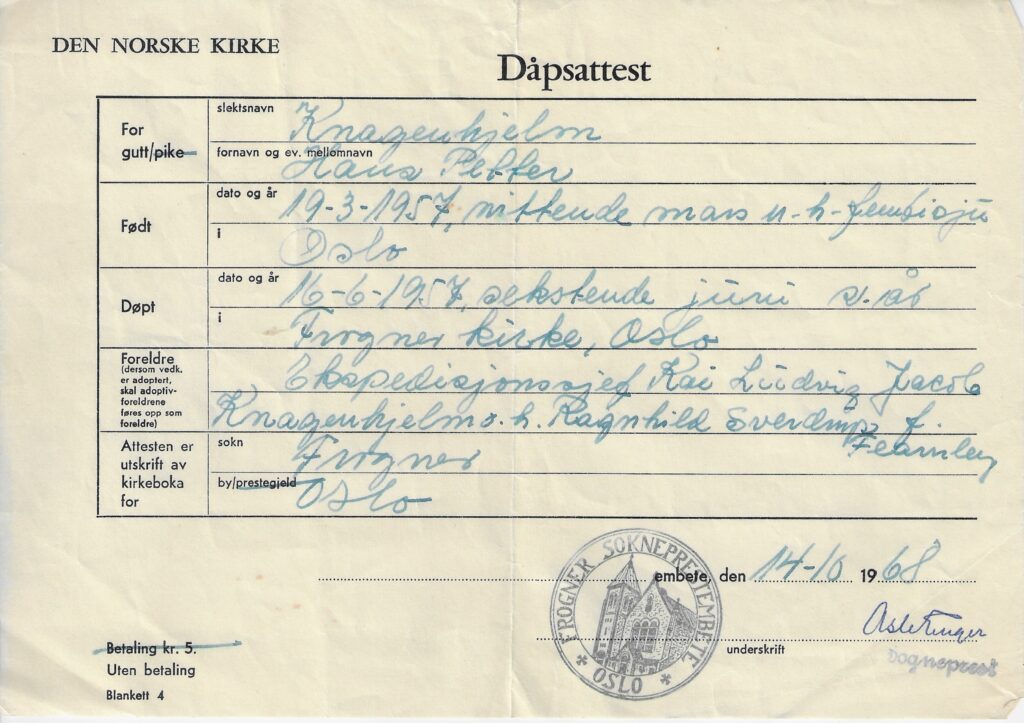
Døpt i Frogner kirke 16/6-57 av ingen mindre enn sogneprest Asle Enger. Vilken ære!
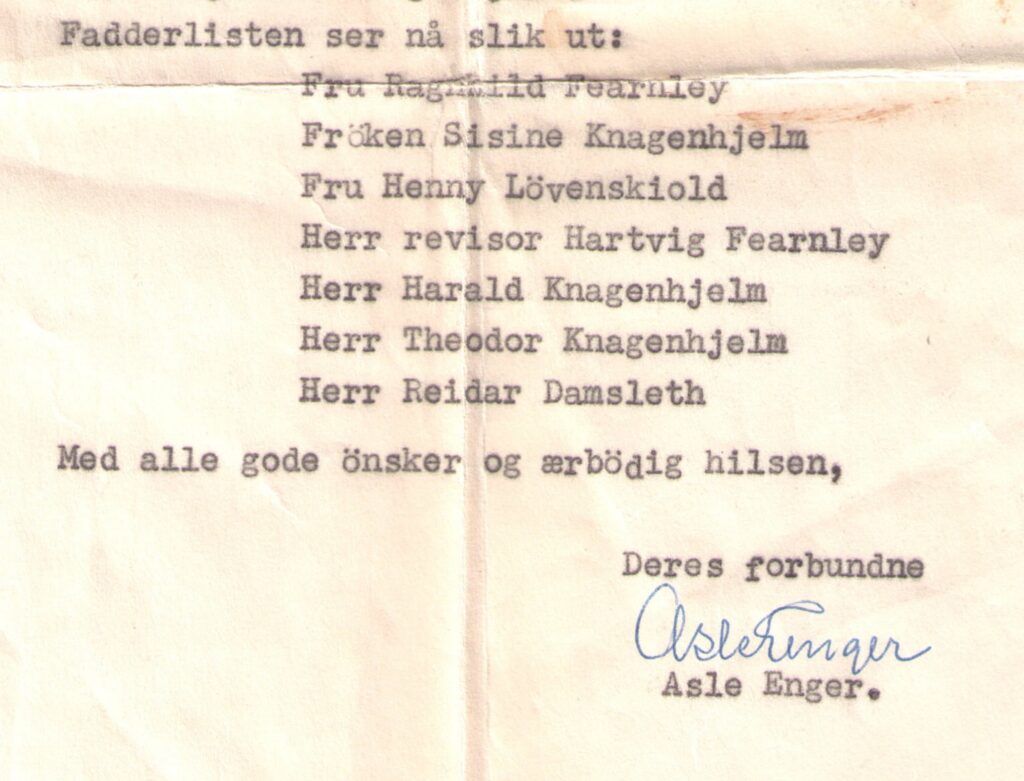
Fadderlisten ble lang, bestemor, tante Ses, konen til fars beste venn (Carl-Otto Lövenskiold), onkel Styggen, to av fars fettere og Kennys mann.
Sang

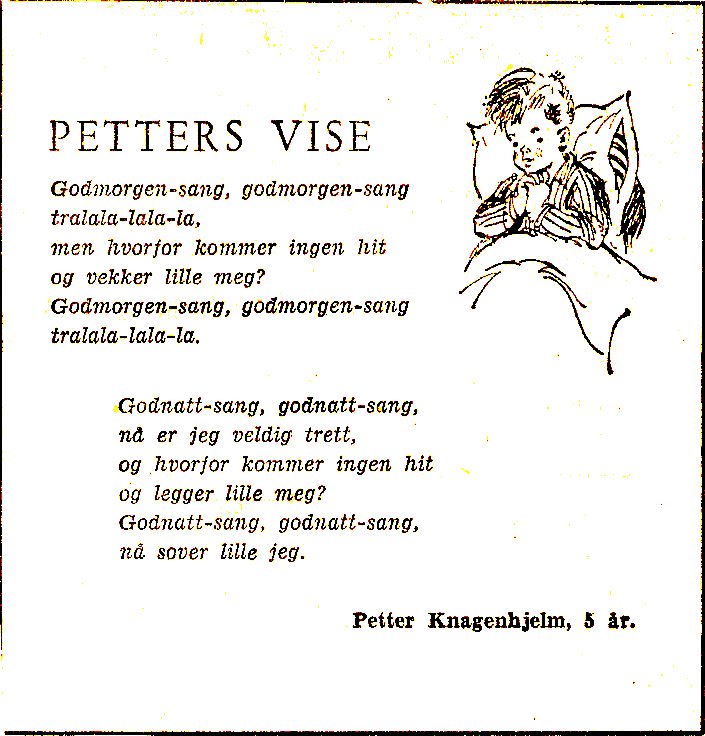
Teater
Jeg var med på utallige radioprogram med mor. Jeg gikk på Marienlyst skole (1. til 6. klasse), så det var enkelt for meg å springe opp til ”Krinken” om hun behøvde en stemme til sine radioprosjekt.
Hun hadde nok en finger med i spillet når roller skulle deles ut på tv også. I hvert fall i begynnelsen. Hun syntes at skuespilleryrke skulle passe meg perfekt. Far var totalt uenig i dette. Jeg skulle konsentrere meg på skolen.
Da det ble litt mye i 1968 med både Lille Eyolf og sene kvelder på Nationaltheatret, bestemte han at nok var nok, og det ble slutten på min ”karriere”.
- Dramagruppen på Marienlyst (m. T-E. Rosnæs, 64-67)
- Stoppested, (NRK 1965)
- Nederlaget, (NRK 1967)
- Den røde pimpernell, (NRK 1967)
- Skipper Worse, (NRK 1967)
- Sycamore Street, (NRK 1967)
- Morderne, (Nationaltheatret, 1968)
- Lille Eyolf, (NRK 1968)
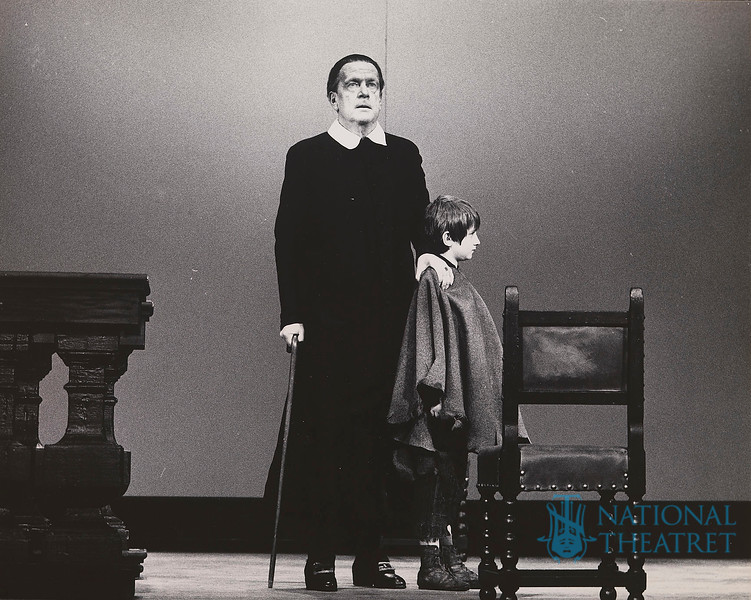
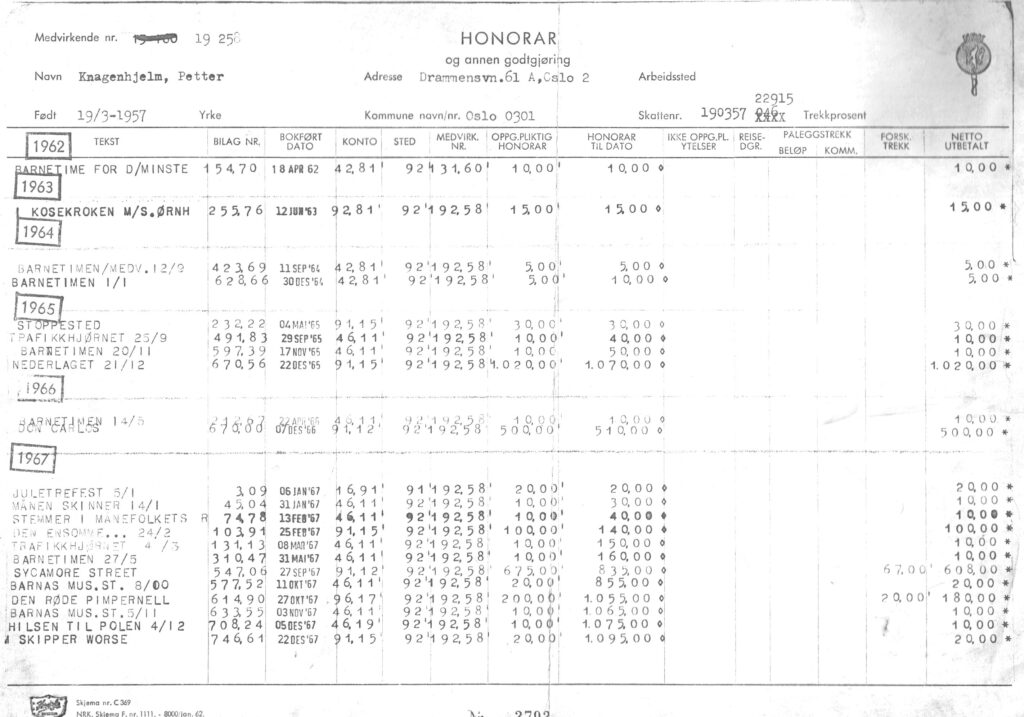
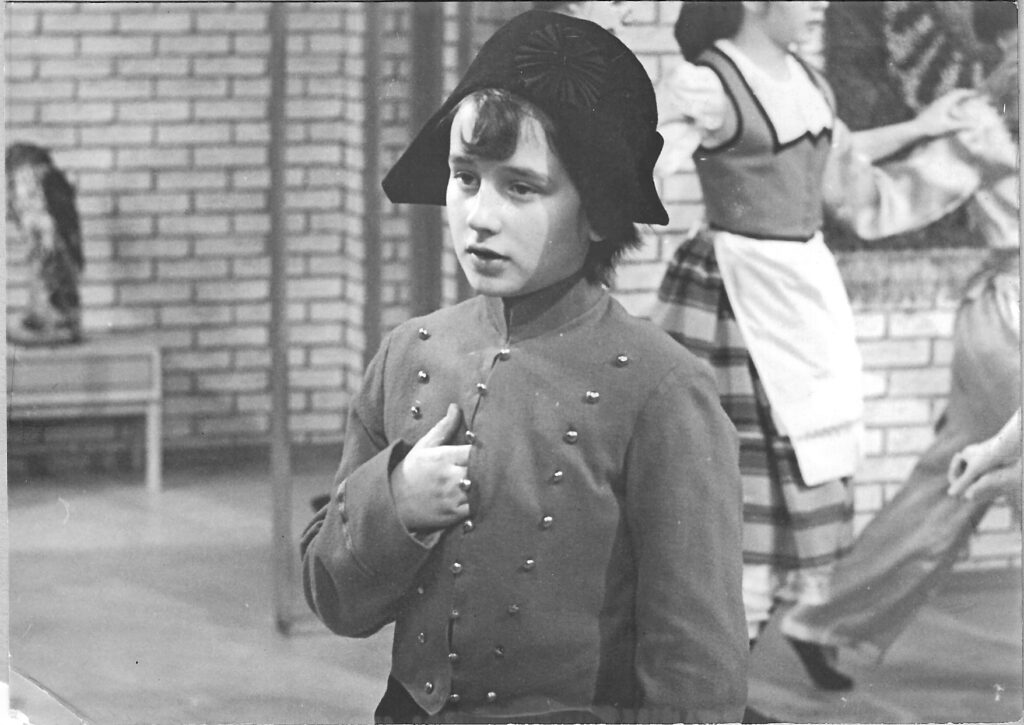
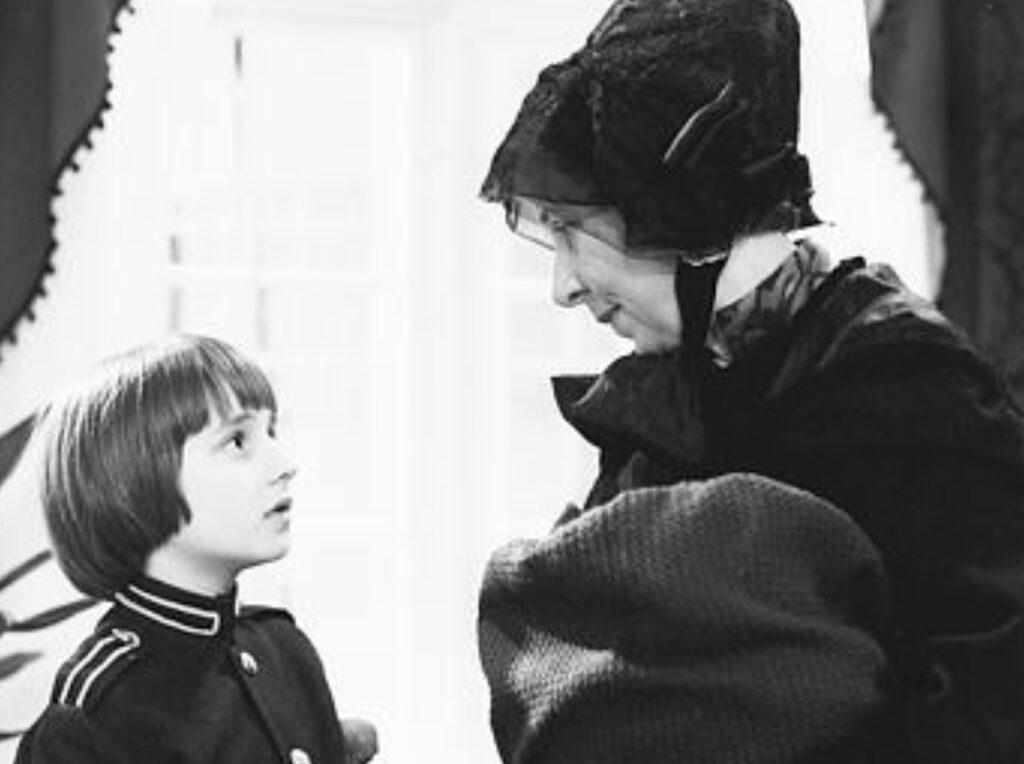

STAKKARS, STAKKARS JULE
NISSE MED DEN STORE
SEKKEN HER DET MÅ
DA VERE VELDIG TONGT
FOR DET ER JO SÅ LANGT
DEN BOR LANGT, LANGT
FRA MENESKENE DEN BOR
OPPE I FJELLENE.
MIN JULENISSE MIN ADVENTSKALENDER ER
DEN FINESTE, FINESTE JULEKALENDER I VERDEN.
DEN HAR ØYNE SÅ BLÅ
SOM HIMMELEN OG SJEGG SÅ
VITT SOM SNE OG KAPPE
SÅ RØD SOM EN ILL.
HAN HAR SÅ BRET
SMIL DET KAN SES MILE
VIS OG SÅ EN STOR EN
SEKK HAN HAR HAN SMILER
LIKEVE
STAKKARS, STAKKARS JULE
NISSE MED DEN STORE, STORE
SEKKEN HER TENK PÅ DEN
STORE VEIEN HAN HAR
MEN ALIKEVEL SMILER
HAN LETT MEN SE PÅ DEN
STORE SEKKEN HAN HAR DEN
ER JO SÅ STOR DEN MÅ VERE
VELDI ….
(her må jeg ha kommet på att jeg gjentar
meg for ofte og slutter defor med noen kruseduller)
Vector Quantization
Signal compression by means of vector quantization (VQ) is an important part of the design of e.g. speech coders. The task of a speech coder is, typically, to reduce the amount of information in the speech signal so that the coded speech can be transmitted on a channel (with limited bandwith), with the best perceived quality possible of the reconstructed speech signal at the receiving end. It is now well known that if a number of samples (or parameters) are compiled into a vector and quantized ”in one go”, beneficial effects are gained compared to quantizing the samples individually (c.f. scalar quantizers, SQ). For instance, a VQ can, in contrast to a SQ, utilize the correlation between samples (parameters). From a theoretical point of view, the dimension of the vector should be as high as possible, which is a nightmare for the practical engineer who deals with aspects like design, search and storage.
A related topic to the design of VQs is the problem of Index Assignment (IA). Each reconstruction vector is assigned an index (number) that, in binary format, is transmitted on the channel. If the channel is corrupted with noise, it is of vital importance that the indices are carefully assigned to the reconstruction vectors so that when errors do occur, the reconstructed signal is affected as little as possible.
A popular source to evaluate design methods and IA algorithms on is the Gaussian source. The Gaussian distribution is attractive because it is relevant for many physical systems, easily generated, analytical tractable, and hard to quantize. It is so common that we have even formed a database containing VQs designed for the Gaussian source (The Gaussian VQ-Base) which can be used for reference, verification etc.
Forskning

The Gaussian VQ-Base @PePe Research
Here you will find Vector Quantizers (VQs) designed for Gaussian sources, using a sample iterative training approach (Kohonen). The VQs are stored as text files, and the coefficients may be viewed in any text editor. Each VQ file has a header of 256 elements (arranged as a 32×8 matrix), containing information on VQ size, file type etc. The header is of limited use for most users, and can of course be removed by any text editor. The VQ is stored as M lines of ndim elements, where M is the number of vectors in the VQ and ndim is the dimension of each vector. A typical code segment (in C) reading the VQ may look like
float vq[MAX_M*MAX_ndim];
short header[256];
FILE *filepointer;
for (i=0; i<256; i++)
fscanf(filepointer,”%hd”, header+i); /* read the header */
M = header[138]; /* extract parameters*/
ndim = header[148];
for (i=0; i<M; i++) /* read the VQ */
for (j=0; j<ndim; j++)
fscanf(filepointer,”%f”, (vq + i*ndim + j));
If you download a VQ file, you will get a text file with linefeed characters that might or might not correspond to linefeed characters on your computer system. Files stored on UNIX machines are typically ready to use, while on e.g. a Macintosh you might have to open the file in a text editor and do a global replace: ”funny” character to ”end of line” character.
Typically, the quantized value is transmitted on a channel by means of the vector index (or number) in binary format. The index is then used at the receiving end for a table lookup of the reconstructed value. If the channel is noisy, the received index may differ from the transmitted, and large errors are possible. One method to reduce the effects of such errors is known as Index Assignment (IA), which in short aimes to assign indices that easily interchange (due to channel errors) to reconstruction values that differ as little as possible. The IA problem is known to be NP-hard, and practical IA algorithms result in suboptimal solutions. A VQ designed for a noiseless channel with a post process IA, is called a Robust Vector Quantizer – RVQ. Several RVQs are included in the RVQ database.
An alternative approach to combat the effects of channel noise is to include channel parameters in the design of the VQ. Such VQs are called Channel Optimized Vector Quantizers – COVQs. The COVQs in this database are designed for the Binary Symmetric Channel (BSC) which is fully determined by one parameter only, the Bit Error Rate (BER). Numerous VQs designed for a variety of BERs are compiled in the COVQ database.
Finally, text files with measurements of the VQ performance are available. For the RVQ database, this file include measurements of Signal to Noise Ratio SNR; the source entropy H(X) and the linearity index l (cf. Knagenhjelm & Agrell ”The Hadamard Transform – A Tool for Index Assignment”). For the COVQ database, this file include measurements of Signal to Noise Ratio SNR; the source entropy H(X); the mutual information I(x,y) and the number of reconstruction vectors used for transmission of data (which is equal to, or less than the number used at the receiver).
VQs
The Thesis
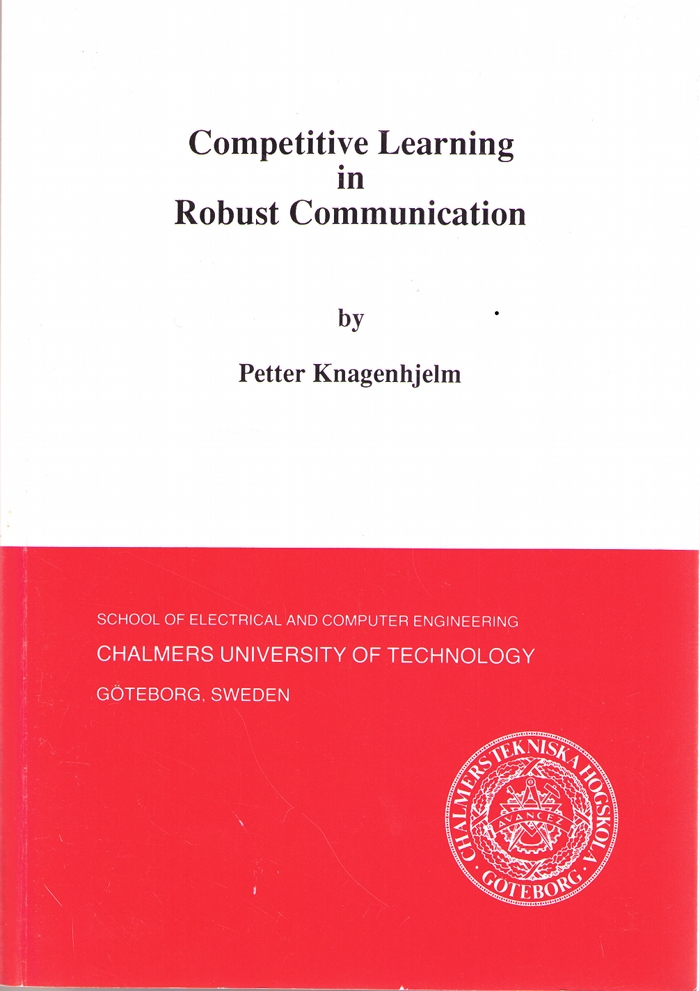
Competitive Learning in Robust Communication
Författare och institution:
Petter Knagenhjelm (Institutionen för informationsteori)
Publikationstyp:
Doktorsavhandling
Förlag:
Chalmers University of Technology
Förlagsort:
Göteborg
Publiceringsår:
1993
Språk:
engelska
Abstract
A modern communication system should be accurate, reliable, robust and make efficient use of the available channel. Vector quantization is beginning to prove its effectiveness for source coding in applications such as cellular mobile telephony. The design of vector quantizers is typically done by clustering methods. A vital part of the design is to incorporate robustness against channel disturbances which may be accomplished by carefully choosing the codewords transmitted on the channel. A joint optimization of the source and channel codes, can be made superior to a separate design of the coders.
This thesis describes non-redundant source/channel coding. Joint source/channel optimization as well as separate optimization of the index assignment are investigated. Algorithms for joint source/channel optimization are developed using a sample-recursive approach.
Although the index-assignment problem is NP-hard, several procedures are developed to find close to optimal solutions. Hypercube mapping is introduced as a convenient way to describe vector quantizers. A new method for index assignment has been developed as a direct consequence of this description. A conceptually attractive, compact, exact analytic expression is derived for the end-to-end distortion for maximum entropy encoders using transmission on binary symmetric channels. Theoretical bounds for the end-to-end distortion are derived. Conditions for reaching the bounds are presented in terms of the linearity of the hypercube mapping.
The theoretical analysis is verified by extensive simulations using Gaussian sources. A database of 250 vector quantizers is made available for public use.
The thesis also concerns iterative algorithms for solving classification problems. Model-based methods as well as methods based on artificial neural networks are investigated. A new fast method has been developed for training a model-based classifier. A new adaption rule is also proposed for Kohonen Feature Maps, which converges faster and improves performance, including recognition rate, compared to previous methods.
Publications
- H Broman, P Hedelin, P Brauer, E Eliassen, D Huber and P Knagenhjelm, ”Classification: a problem of optimization or of organization?,” in Proceedings of the Symposium DIGITAL COMMUNICATION, Stockholm, Sweden, 1989.
- P Brauer and P Knagenhjelm, ”Infrastructure in Kohonen maps,” in Proceedings of the IEEE International Conference on Acoustics, Speech and Signal Processing (ICASSP-89), pp. 647-650, Glasgow, Scotland, May 1989.
- P Knagenhjelm and P Brauer, ”Classification of vowels in continuous speech using MLP and a hybrid net,” in Speech Communication, vol. 9, no. 1, pp. 31-34, February 1990.
- P Brauer, P Hedelin, D Huber and P Knagenhjelm, ”Probability based optimization for network classifiers,” in Proceedings of the IEEE International Conference on Acoustics, Speech and Signal Processing (ICASSP-91), pp. 133-136, Toronto, Canada, May 1991
- P Brauer, P Hedelin, D Huber, P Knagenhjelm and J Molnö, ”Model or non-model based classifiers,” in Proceedings of the Third European Conference on Speech Communication and Technology (EUROSPEECH-91), pp. 1027-1030, Genova, Italy, September 1991.
- P Knagenhjelm, ”A recursive design method for robust vector quantization,” in Proceedings of the International Conference on Signal Processing Applications and Technology (ICSPAT-92), pp. 948-954, Boston, November 1992.
- P Knagenhjelm, ”Integrated index assignment, source and channel coding,” in Proceedings of the International Symposium on Information Theory ( ISIT-93), p. 339, San Antonio, January 1993.
- P Knagenhjelm, ”The Gaussian VQ-Base @ Information Theory,” technical report no. 11, Department of Information Theory, Chalmers University of Technology, April 1993.
- P Knagenhjelm, ”How good is your Index Assignment?,” in Proceedings of the IEEE International Conference on Acoustics, Speech and Signal Processing (ICASSP-93), pp. 423-426, Minnesota, April 1993.
- P Knagenhjelm, ”Robust Vector Quantization. (Tutorial)”. Technical Report no. 12, Department of Information Theory, Chalmers University of Technology, May 1993.
- P Knagenhjelm, ”Competitive Learning in Robust Communication.”, Ph.D. Dissertation, Department of Information Theory, Chalmers University of Technology, June 1993.
- P Knagenhjelm and E Agrell, ”The Hadamard transform – a tool for index assignment.” To appear in IEEE Trans. on Information Theory, 1996.
- P Knagenhjelm and W.B. Kleijn, ”Spectral Evolution is more important than Spectral Distortion.” Proceedings of the IEEE International Conference on Acoustics, Speech and Signal Processing (ICASSP-95), pp 732-735, Detroit, MI, May 1995.
- P. Hedelin, P.Knagenhjelm, and M. Skoglund, ” Vector quantization for speech transmission,” in Speech Coding and Synthesis, W.B. Kleijn and K.K Paliwal, eds., Elsevier, 1995 (35 pages).
- P. Hedelin, P.Knagenhjelm, and M. Skoglund, ” Theory for transmission of vector quantization data,” in Speech Coding and Synthesis, W.B. Kleijn and K.K Paliwal, eds., Elsevier, 1995 (49 pages).
Observe that [11] contains [2-6] and [8-10]
Patents
- Henrik Bergfalk, Petter Knagenhjelm: Detection of psychological disorder activity patterns. November 2005: US 20050245790 (4 worldwide citation)
- Willem Bastiaan Kleijn, Hans Petter Knagenhjelm: Speech coding parameter smoothing method. Lucent Technologies October 1997: US 5675701 (2 worldwide citation)
- Ove Eklund, Henrik Bergfalk, Jan Anders Hedner, Hans Petter Knagenhjelm: Auto CPAP. Breas Medical May 2005: US 6889691 (2 worldwide citation)
- Jan Hedner, Petter Knagenhjelm, Mikael Tiedje, Lutger Grote: Multilevel Ventilator. Breas Medical October 2008: US 20080257349 (1 worldwide citation)
- Petter Knagenhjelm: Pattern analysis system and method. Petter Knagenhjelm July 2003: EP1323377
- Petter Knagenhjelm: Pattern analysis system and method. August 2003: US 20030153817 Method and arrangement for providing a computerized system having an interface arrangement for interfacing a data source. The data source delivering data related to motion of a person, a memory arrangement for storing said data, a processor for processing the data, an artificial neural network
- Henrik Bergfalk, Petter Knagenhjelm: Detection of psychological disorder activity patterns. Qbtech May 2010:US 7720610 A method for detecting a psychological disorder in a person comprises collecting movement and, optionally, other data from the person by a device borne by the person; storing the data in a memory in contact with the device during the collection of data; transferring the stored data to a computer; …
- Petter Knagenhjelm: Pattern analysis system and method. Concepta August 2008: US 7409373 Method and arrangement for providing a computerized system having an interface arrangement for interfacing a data source. The data source delivering data related to motion of a person, a memory arrangement for storing said data, a processor for processing the data, an artificial neural network …
- Knagenhjelm Petter: Pattern analysis system and method. / Systeme et methode d’analyse de formes. CA 2415444
